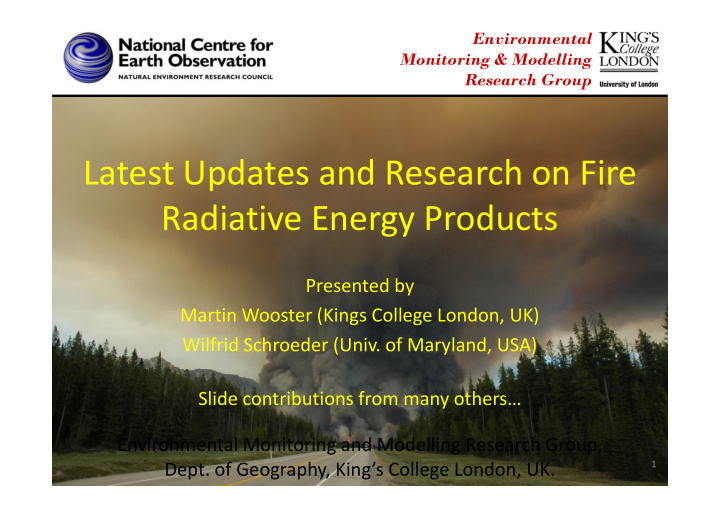



������������� ����������������������� �������������� Latest Updates and Research on Fire Radiative Energy Products Presented by Martin Wooster (Kings College London, UK) Wilfrid Schroeder (Univ. of Maryland, USA) Slide contributions from many others… Environmental Monitoring and Modelling Research Group, 1 Dept. of Geography, King’s College London, UK.
FRP Products [NRT Operational] [NRT Operational] 2
Operational SEVIRI FRP_Pixel Product Europe Global product generated from FRP N. Africa pixel derived for different dates only as a visual example South S. Africa America 4 Processing Regions Available via FTP/EUMETCast from the EUMETSAT Land Surface Analysis Satellite Application Facility (LSA SAF) http://landsaf.meteo.pt/ - for data, ATBD, Product User Manual & Validation Report • FRP Pixel Product (native spatial/temporal resolution) – available within 30 mins • FRP Gridded product - inc. adjustments for “small fires” and “clouds” also available.
SEVIRI FRP_Pixel – Quality Product Two HDF files for each slot FRP_Pixel Quality Product File • “List Product”- Fire Data only • Matching “Quality Product” QUALITY FLAG coding reports the processing status of each pixel – Fire Detected & FRP measured, cloud-covered, FRP measured, cloud-covered, etc. VALUE MEANING ---------------------------------------- 0 NOT POT FIRE 1 FRP OK 2 FRP SAT 3 CLOUDY 4 SUN GLINT 5 SUN GLINT RATIO 6 NO BCK 7 BAD BCK 8 CLOUD EDGE 254 NOT PROCESSED
GOES FRP Product (America’s) July 2007 N. America GOES W S. America GOES E • Available on request in NRT from KCL now (users ECMWF and Met Office Currently) • End of next year should be available from LSA SAF
Expected Global Geostationary System GOES-E: GOES-W: Meteosat: Future operational Future operational Operational currently generated @ currently generated @ via LSA SAF KCL but available to KCL but available to users users + Meteosat Third Generation MTSAT: FY2: (2017+) will have: Maybe future Future operational operational @ CMA • improved temporal resolution currently prototyped @ currently prototyped @ KCL KCL • 2 km spatial resolution (SSP) • wide range 3.9 µm band. Non-Optimum 3.9 µm Non-Optimum 3.9 µm channel data quality channel dynamic range
Global Fire Assimilation System (GFAS) Global FRP and Atmospheric Global FRP and Atmospheric Emissions Dataset [NRT Operational and Reanalysis] 7
FRP to Fire Emissions Operational deployment of FRP product via EUMETSAT LSA SAF : http://landsaf.meteo.pt/ Combined with MODIS FRP - then used to model fire chemical emissions in prototype GMES Atmospheric Core Service @ ECMWF http://www.gmes-atmosphere.eu/ Observed Global FRP Areal Density Modelled CO Biomass Burning Tracer
Global Fire Assimilation System (GFAS v1) NUMBER OF MODIS OSBERVATIONS FRP Areal Density FRP Areal Density TERRA TERRA Fuel Consumption AOD Rate (g[C] m -2 d -1 ) AQUA Part of the EU FP7 Monitoring Atmospheric Chemistry and Climate (MACC) Project: Products @ www.gmes-atmosphere.eu Kaiser et al. (2011) www.biogeosciences-discuss.net/8/7339/2011/bgd-8-7339-2011.html
Mean Annual Fuel Consumption 2003-2009 [Spatial Patterns and Ratio] Global Total: 4.0 Pg year -1 Global Total: 4.9 EJ year -1 GFED3.1 GFAS1.0 DM burned [g DM m -2 year -1 ] DM burned [g DM m -2 year -1 ] FRE [kJ m -2 year -1 ] FRE [kJ m -2 year -1 ] CF W -DM equivalent (DME): 1.8 Pg year -1 � GFED3.1 DM estimates 2.2 times higher than GFAS1.0 DME globally � GFED3.1 notably higher in the boreal belt and in the tropics � GFAS1.0 higher in NH temperate Global Mean Ratio: 0.81 regions � GFAS1.0 greater spatial extent CF GFED3.1/GFAS1.0 [g kJ -1 ] of areas affected by fire CF W : 0.368 g kJ -1
Effective fuel-type dependent CF scaled to GFED3.1 30 500 SA SAOM Derivation of conversion factors (CF) from linearly 25 400 regressing monthly GFED3.1 DM with GFAS1.0 FRE 20 300 15 GFED3.1 [Tg] 200 10 GFAS1.0 [PJ] 100 5 800 Tg or PJ month -1 0 0 0 100 200 300 400 500 0 5 10 15 20 25 30 600 30 30 AG AGOM M month-1) 25 25 20 20 400 15 15 10 10 200 200 GFED3 DM (Tg DM 5 5 5 5 0 0 0 5 10 15 20 25 30 0 5 10 15 20 25 30 0 2003 2004 2005 2006 2007 2008 2009 PE TF 300 300 Year 200 200 Predominant Fuel Class 100 100 Linear SA AG DF EF SAOM AGOM PEAT EFOM ALL 0 0 Regres. 0 100 200 300 0 100 200 300 R 2 40 86% 58% 55% 50% 77% 54% 57% 86% 74% EF EFOM 300 30 Slope 0.78 0.29 0.96 0.49 0.26 0.13 5.87 1.55 0.85 200 [g kJ -1 ] 20 100 CF W : 0.368 g kJ -1 10 0 0 0 100 200 300 0 10 20 30 40 Kaiser et al. (2011) www.biogeosciences-discuss.net MODIS-FRE (PJ month-1)
GFED3.1 Non-Detection Areas 2003-2009 Areas where GFAS1.0 shows Burning but GFED3.1 not Frequent Fires in GFAS1.0 GFAS1.0 Croplands or Savannah FRE [kJ m -2 year -1 ] N monthly fire observations [months] � 33% of grid cells with GFAS1.0 fire observations not detected by GFED3.1: - typically low fuel consumption (< 2.7 kJ m -2 year -1 ) - repeated small fires in savanna, deforestation and agricultural areas 10% 5% - contribute < 3% to global FRE EF � Only 0.1% of grid cells with GFED3.1 fire observations 0.5% 39% not detected by GFAS1.0 SA 36% 1% DF 9% AG www.biogeosciences-discuss.net/8/7339/2011/bgd-8-7339-2011.html
Next Step: SEVIRI to MODIS Merging
Recommend
More recommend